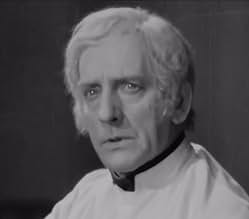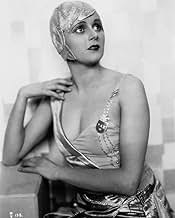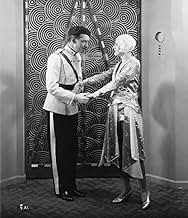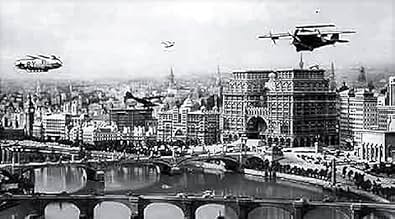Ajouter une intrigue dans votre langueWomen unite to prevent financiers from engineering a second world war.Women unite to prevent financiers from engineering a second world war.Women unite to prevent financiers from engineering a second world war.
- Réalisation
- Scénaristes
- Stars
- Récompenses
- 1 victoire au total
Edith Barker Bennett
- Minor Role
- (non crédité)
James Carew
- Lord Rowleigh
- (non crédité)
Alf Goddard
- Tele-radiographer
- (non crédité)
Judd Green
- James Groves
- (non crédité)
Clifford Heatherley
- Delegate
- (non crédité)
Hayford Hobbs
- Charles Falloway
- (non crédité)
Allan Jeayes
- Border Guard
- (non crédité)
Raymond Massey
- Member of Federated States Council
- (non crédité)
Wally Patch
- Peace League Commissionaire
- (non crédité)
Irene Rooke
- Senator
- (non crédité)
Milton Rosmer
- Ernest Stratton
- (non crédité)
John Singer
- Boy
- (non crédité)
Kiyoshi Takase
- Arms Manufacturers' Henchman
- (non crédité)
6,1247
1
2
3
4
5
6
7
8
9
10
Avis à la une
Maurice Elvey Tackles Science Fiction
HIGH TREASON was originally issued in both sound and silent versions, but for many years, only the silent version was known to survive. A few years ago, a copy of the abbreviated sound version, issued by Tiffany in the US was discovered and restored. However, it is still difficult to see, and so this review is based on the silent version.
The year is 1950 -- a popular year for science-fiction films in the 1920s -- and tensions are rising between the Federated States of Europe and the Atlantic States. A car carrying liquor breaks through a border guard and is shot down; the Atlantic States send an ultimatum to Europe, whose President, Basil Gill, wants war; although he is not implicated, arms manufacturers are shown bribing people. Only the World League of Peace, led by Humberstone Wright, and his daughter, Benita Hume, stand in the way of war. Miss Hume's boy friend is Jameson Thomas, an officer of Europe, ready to carry out his orders. Thus the conflict is not only a matter of the world and politics and money, but of love.
Visually, the movie is an Art Deco feast, pitched halfway between METROPOLIS and THINGS TO COME (Raymond Massey, who starred in the latter, has a small but prominent role and can be clearly seen at about the 30-minute mark). Clothes follows the sleek design, with a lot of shiny fabric and hats midway between cloches and skullcaps. Neither does Elvey neglect the technological touches, with autogyros and biplanes flying about London, television broadcasts, sliding doors and the other paraphernalia beloved of screen sf. Percy Strong's camerawork is limber, with many a tracking shot to focus the audience's attention, and a couple of moving crane shots. British film-making may have long been considered a backwater of the industry, but British Gaumont had the resources and will to make this spectacular.
The weaknesses of this movie are twofold. First, it is very talky for a silent picture, with a lot of title cards of dialogue, doubtless reproducing speech in the sound version. Second is the rather clunky utopianism of the plot, reducing the issues of politics and economics in a theoretical world to melodrama, where singing a song can stop a military action, and national leaders can be isolated from their guards. In my rather cynical view, Realpolitik guides the powerful, who are isolated and protected from the consequences of their follies.
Still, that's no way to make popular entertainment now, and was less so in 1929; and while this movies shows flaws that an examination of the sound version might more fully explain, it remains visually quite beautiful, with the lovely 23-year-old Miss Hume a high point.
The year is 1950 -- a popular year for science-fiction films in the 1920s -- and tensions are rising between the Federated States of Europe and the Atlantic States. A car carrying liquor breaks through a border guard and is shot down; the Atlantic States send an ultimatum to Europe, whose President, Basil Gill, wants war; although he is not implicated, arms manufacturers are shown bribing people. Only the World League of Peace, led by Humberstone Wright, and his daughter, Benita Hume, stand in the way of war. Miss Hume's boy friend is Jameson Thomas, an officer of Europe, ready to carry out his orders. Thus the conflict is not only a matter of the world and politics and money, but of love.
Visually, the movie is an Art Deco feast, pitched halfway between METROPOLIS and THINGS TO COME (Raymond Massey, who starred in the latter, has a small but prominent role and can be clearly seen at about the 30-minute mark). Clothes follows the sleek design, with a lot of shiny fabric and hats midway between cloches and skullcaps. Neither does Elvey neglect the technological touches, with autogyros and biplanes flying about London, television broadcasts, sliding doors and the other paraphernalia beloved of screen sf. Percy Strong's camerawork is limber, with many a tracking shot to focus the audience's attention, and a couple of moving crane shots. British film-making may have long been considered a backwater of the industry, but British Gaumont had the resources and will to make this spectacular.
The weaknesses of this movie are twofold. First, it is very talky for a silent picture, with a lot of title cards of dialogue, doubtless reproducing speech in the sound version. Second is the rather clunky utopianism of the plot, reducing the issues of politics and economics in a theoretical world to melodrama, where singing a song can stop a military action, and national leaders can be isolated from their guards. In my rather cynical view, Realpolitik guides the powerful, who are isolated and protected from the consequences of their follies.
Still, that's no way to make popular entertainment now, and was less so in 1929; and while this movies shows flaws that an examination of the sound version might more fully explain, it remains visually quite beautiful, with the lovely 23-year-old Miss Hume a high point.
Not so passive resistance in this very strange sci-fi flick.
I have read that BLACKMAIL (directed by Alfred Hitchcock) was the first British talking picture. I was sure surprised when I learned that HIGH TREASON came out several months earlier. In both cases, they made sound and silent versions because most British theaters were not equipped for sound. I found the silent version and would love to see the sound version if I can find it.
The story is a natural outgrowth of WWI, which just ended a decade earlier. Millions of men were needlessly slaughtered in a war which had no 'good guys'...just victims. Because of this, many anti-war films were made in the 1920s and 30s...all hoping to convince everyone that war was avoidable and useless. Too bad they hadn't anticipated the rise of Naziism and, unfortunately, these films actually HELPED the Third Reich to gain control over Europe, as the films were particularly popular in Britain (such as with this film and THINGS TO COME) and France (such as with both versions of J'ACCUSE).
The film is set in 1950. Europe and North America have each formed a separate union--with the Federated States of Europe and the Atlantic States each representing many millions of people. A small border incident* occurs and instead of dealing with it like adults, the leaders begin preparing for war--fomented by evil industrialists who will profit from death. The only thing standing in the way is a large group of peace-lovers who are members of The World League of Peace....with 25,000,000 members who are willing, in some cases, to give their lives to maintain peace and prevent another senseless war. How this war is averted is fascinating....and gives an interesting twist to the notion of passive resistance!
This is a cool film to watch, as their view of the future is amazingly dated--with everyone flying about in dirigibles, auto-gyros and airplanes. The look of all this is pretty silly in some ways (sort of like THE JETSONS) but also is fascinating to see. Overall, a fascinating look at what if....and well worth seeing, particularly if you are a history buff like me.
The story is a natural outgrowth of WWI, which just ended a decade earlier. Millions of men were needlessly slaughtered in a war which had no 'good guys'...just victims. Because of this, many anti-war films were made in the 1920s and 30s...all hoping to convince everyone that war was avoidable and useless. Too bad they hadn't anticipated the rise of Naziism and, unfortunately, these films actually HELPED the Third Reich to gain control over Europe, as the films were particularly popular in Britain (such as with this film and THINGS TO COME) and France (such as with both versions of J'ACCUSE).
The film is set in 1950. Europe and North America have each formed a separate union--with the Federated States of Europe and the Atlantic States each representing many millions of people. A small border incident* occurs and instead of dealing with it like adults, the leaders begin preparing for war--fomented by evil industrialists who will profit from death. The only thing standing in the way is a large group of peace-lovers who are members of The World League of Peace....with 25,000,000 members who are willing, in some cases, to give their lives to maintain peace and prevent another senseless war. How this war is averted is fascinating....and gives an interesting twist to the notion of passive resistance!
This is a cool film to watch, as their view of the future is amazingly dated--with everyone flying about in dirigibles, auto-gyros and airplanes. The look of all this is pretty silly in some ways (sort of like THE JETSONS) but also is fascinating to see. Overall, a fascinating look at what if....and well worth seeing, particularly if you are a history buff like me.
Basil Gill's quality of voice
Ther actor Basil Gill was famous in his time for his fine voice. He was an accomplished stage actor before starting work in the early cinema. There were numerous press reviews of his performances that commented on his voice, and those that accompanied the release of this film, the talking version, in 1928, were no exception. "Basil Gill as President Stephen Deane has far and away the best recording voice we have heard, a lesson to everyone in clearness and beautiful quality." What a shame that the sound is no longer audible. However, his voice can still be heard in such films as "Knight without Armour", "Rembrandt", "St Martin's Lane" and "Wings of the Morning".
TALKIE-VERSION THOUGHT LOST...NOT...PRISTINE PRINT FOUND...AN EYE-POPPING SURREAL ART-DECO...WOW
Produced Simultaneously as a "Sound" and "Silent" Film, this Highly-Stylized War-Anti-War Film, is an Arresting, Awesome, Audacious Movie Made at the Precise Moment America and Britain were Contemplating, Not Only the Future of Film-Making but the "Future" of War, Technology, Creature Comforts, and the "Roles" of Men and Women in Daily-Life.
The Movie Only Existed in a Silent Version Until Very Recently when a "Talkie" Print Emerged from the Rubble of Time.
"Lost-Media" Hopefuls, Once Again, are Given Proof-Positive, that Adapting a "Positive" Attitude that there May Be Found, "Cross-Fingers", an Existing Print of All Things "Media" Thought Lost is "Not".
"High Treason" is Surely a Powerful Treat for the Eyes with its Stunning Art-Deco Images and its Imaginative World-Building that is Elaborately Executed and Shown to be Both Awe-Inspiring and Clunky.
For an Example of said Clunky, Awkward is the Display of a Dance-Hall where the "Guys and Gals" are Stepping Staccato (start & stop) to a Band of Instruments On-Stage.
A Band of Instruments Playing Without Humans Involved.
It's sort of a "Goldberg" Kinda Thing with Wires and Other Hardware Forcing Air into the Woodwinds with Levers and Such Plucking Others. It's One of the More Ridiculous Displays.
The Things Most Impressive are the Communication Devices (Skype-Like), and a Stab at Cars, Aircraft, and Transportation.
At its Heart is its Pacifistic Foundation.
Women with More of a Role in Society and Government, but its also Not Above being Playfully Erotic at Times.
An Odd, Surreal Look at the Future that can Boggle-the-Mind and Spirit with its Wonderfully Poetic Visuals that Dominate the Feature.
The Acting, as Expected is Dated, as are some of its Attitudes about Almost Everything, but Not that Absurd if You Think About it.
"High Treason" is a Daring "Hidden Gem" that can be Placed, with Certitude, Along-Side other Pre-1950 Extravaganzas of Science-Fiction such as...
"Metropolis" (1925)..."Just Imagine" (1930), "Things to Come" (1936).
Must-See for Film-Historians, Sci-Fi Fans, and those Seeking Spectacle.
Or Anyone Wanting to be "Blown Away" by the Art of Movie-Making with Accent on "Art".
With a Dollop of Social Commentary, Prognostication, as Pure Entertainment...
It's a WOW.
The Movie Only Existed in a Silent Version Until Very Recently when a "Talkie" Print Emerged from the Rubble of Time.
"Lost-Media" Hopefuls, Once Again, are Given Proof-Positive, that Adapting a "Positive" Attitude that there May Be Found, "Cross-Fingers", an Existing Print of All Things "Media" Thought Lost is "Not".
"High Treason" is Surely a Powerful Treat for the Eyes with its Stunning Art-Deco Images and its Imaginative World-Building that is Elaborately Executed and Shown to be Both Awe-Inspiring and Clunky.
For an Example of said Clunky, Awkward is the Display of a Dance-Hall where the "Guys and Gals" are Stepping Staccato (start & stop) to a Band of Instruments On-Stage.
A Band of Instruments Playing Without Humans Involved.
It's sort of a "Goldberg" Kinda Thing with Wires and Other Hardware Forcing Air into the Woodwinds with Levers and Such Plucking Others. It's One of the More Ridiculous Displays.
The Things Most Impressive are the Communication Devices (Skype-Like), and a Stab at Cars, Aircraft, and Transportation.
At its Heart is its Pacifistic Foundation.
Women with More of a Role in Society and Government, but its also Not Above being Playfully Erotic at Times.
An Odd, Surreal Look at the Future that can Boggle-the-Mind and Spirit with its Wonderfully Poetic Visuals that Dominate the Feature.
The Acting, as Expected is Dated, as are some of its Attitudes about Almost Everything, but Not that Absurd if You Think About it.
"High Treason" is a Daring "Hidden Gem" that can be Placed, with Certitude, Along-Side other Pre-1950 Extravaganzas of Science-Fiction such as...
"Metropolis" (1925)..."Just Imagine" (1930), "Things to Come" (1936).
Must-See for Film-Historians, Sci-Fi Fans, and those Seeking Spectacle.
Or Anyone Wanting to be "Blown Away" by the Art of Movie-Making with Accent on "Art".
With a Dollop of Social Commentary, Prognostication, as Pure Entertainment...
It's a WOW.
Futuristic drama with a message of peace
THE STORY & GENRE -- Munitions scumbags start war with agitprop and false flags, peaceniks block aerodrome & shoot hawk President. Not the most sophisticated film but provides plenty of food for thought. Futuristic sets (cities, travel, Chunnel) & technology (war, communications, household).
THE VERDICT -- Having seen both the silent and sound versions, I recommend you should watch the silent, by far the better experience. Maurice Elvey's frantic direction suffers too much from the weak technicals and dialogue delivery in the sound version.
FREE ONLINE, the Gaumont print at 75 minutes, which may be just a fast running of the 82-minute IMDB duration.
THE VERDICT -- Having seen both the silent and sound versions, I recommend you should watch the silent, by far the better experience. Maurice Elvey's frantic direction suffers too much from the weak technicals and dialogue delivery in the sound version.
FREE ONLINE, the Gaumont print at 75 minutes, which may be just a fast running of the 82-minute IMDB duration.
Le saviez-vous
- AnecdotesMade in separate silent and sound versions. While a mute negative of the sound version had been kept by the UK National Film Archive since 1981, it was thought that all sound elements were lost. However, a 35mm fine-grain nitrate print of the sound version was found in 2005 on Vashon Island, WA, by the Alaska Moving Image Preservation Association and was preserved by the US Library of Congress.
- Citations
Michael Deane: Cold soup is worse than any war.
- Versions alternativesreleased in all talkie and silent versions
- ConnexionsFeatured in Loin de Hollywood - L'art européen du cinéma muet (1995)
Meilleurs choix
Connectez-vous pour évaluer et suivre la liste de favoris afin de recevoir des recommandations personnalisées
Détails
- Durée
- 1h 35min(95 min)
- Couleur
Contribuer à cette page
Suggérer une modification ou ajouter du contenu manquant




























